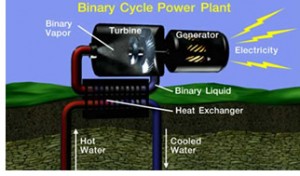While alternative energy continues to get a boost from the Obama administration, geothermal still doesn’t seem to be garnering much of the spotlight. However, the energy sector is growing and recently the state of Idaho announced that it will increase its percentage of energy output from wind, solar and biomass and is looking to add more geothermal derived energy.
Based its 20 year Integrated Resource Plan (IRP) filed with the state last December, the most promising form of geothermal energy for Southern Idaho is binary cycle geothermal development. In this type of plant, the hot geothermal water is passed through a heat exchanger which then heats a binary liquid. From there, the liquid is vaporized and the vapor spins the turbine-generator unit where it is then reliquefied and reused in the heat exchanger. After a portion of geothermal water is used for heat, it exits the plant and is returned back to the reservoir.
The first project, Raft River, is already producing electricity and Idaho Power is looking to develop additional projects over the next decade. To date there are only 12 binary cycle geothermal plants in operation in the US.
In the near-term, Idaho Power plans on adding 266MW of wind capacity in 2010 through long-term power purchase contracts and plans to have over 600MW of wind by the end of 2012. In addition, they have hired Black and Veatch to conduct a feasiblity study for solar techologies.
In an effort to increase geothermal funding and projects across the US, the industry is gathering in San Francisco next week for the GeoPower Americas conference where the goal is to raise more attention to this promising form of alternative energy.


